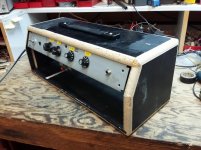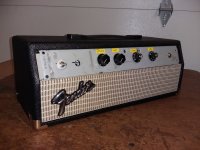I'm building a cabinet for a Princeton clone I built (see pic), and will be putting a grill- cloth-covered panel below the chassis in front. Question: is the panel solid, or have ventilation holes, or a frame, or what? I plan on it being about 3/16" thick, and screwed to wood pieces on each side. The only Fender amp I own is a combo. Any help? Thanks!
Attachments
Solid wood.
For reference:
Blackface Princeton Reverb® Style Guitar Amplifier Head Cabinet - Mojotone.com
For reference:
Blackface Princeton Reverb® Style Guitar Amplifier Head Cabinet - Mojotone.com
Thanks Enzo. I've seen the Mojotone website, still wasn't sure if it was solid or not. I plan to attach the cloth with the same tolex glue, will find out how that works. My old Fender Champ has some staples on it's tolex, is that original or added by the owner later? It's around a 1978, from "Fullerton, CA"....
Or not?
It's your amp man, do what you want.
I have a Fender Princeton combo and it is only open at the back. So as long as the back can get air I suppose it should be OK too.
But, I think they look pretty cool when you can see that nice glow inside the amp. Of course I have zero amps that you can see the tubes. but I still think it looks cool.
It's your amp man, do what you want.
I have a Fender Princeton combo and it is only open at the back. So as long as the back can get air I suppose it should be OK too.
But, I think they look pretty cool when you can see that nice glow inside the amp. Of course I have zero amps that you can see the tubes. but I still think it looks cool.
Yep it's my amp, although I am putting a Fender logo on the grill. Just want people to look twice at it 😉
I also bought a reverb tank, and found a SS schematic for a pre/post driver that uses the high B+ circuit voltage, so it'll be a "vibro-verb" (already has a tube tremolo in it).
Cool!
If you put a solid piece of wood you could use something really nice, like a flamed maple or cocobola or something?
If you put a solid piece of wood you could use something really nice, like a flamed maple or cocobola or something?
Maybe on my next cabinet. This is only the second one I've built, and just want to see how close to a classic Fender I can get. Didn't know what a dado joint was 3 months ago lol. Here's my first - for an old Webcor phono amp. Will be putting a black screen on it.... So far Tolex is been fun, but doing corners without a cap (to cover the ugly) will be a challenge...
Attachments
If you are covering the panel with grille cloth, why not mount it like grille cloth. Tolex is easy to glue because it is not porous. I would not want to promise that glue under grille cloth would not migrate through the weave.
I'd just stretch and staple just the same as if it was open in the center and had a speaker behind it. The main challenge is keeping the weave lines straight.
On a typical Fender head cab, you know what that half panel across the open rear is for? It helps set up convection cooling. By dividing the rear opening into the upper and lower, the heat escaping up top, draws air through the lower opening. If we remove the half panel, then hot air still rises, but cooler makeup air is not deflected in towards the tubes. SO don't leave off the rear part.
I'd just stretch and staple just the same as if it was open in the center and had a speaker behind it. The main challenge is keeping the weave lines straight.
On a typical Fender head cab, you know what that half panel across the open rear is for? It helps set up convection cooling. By dividing the rear opening into the upper and lower, the heat escaping up top, draws air through the lower opening. If we remove the half panel, then hot air still rises, but cooler makeup air is not deflected in towards the tubes. SO don't leave off the rear part.
Thanks Enzo, I'll just staple it. About convection cooling - I have a rear panel with a long opening in it. The amp chassis is 1 inch less deep than the cab, so air should convect in from below and out behind the chassis. I could easily holesaw some 2" holes in the front panel, but don't want them visible - will test it on my cloth. Oh, and I've read about glueing real tweed, with some kind of animal-based glue, and the ugly caused by seepage. I bought some faux tweed tolex for my next project (that Peavey 410 VT Classic)...
The stock Fender back also keeps young fingers out of the hot tubes, and are less than optimal. Head cabinets of limited height and the chassis on the top can have particular problems. Not a Princeton so much, but a SuperTwin chassis in a head cabinet.
A much more effective Fender cabinet back would have an "L" shape, forcing the incoming cool air farther inside the cabinet. And a taller cabinet improves the chimney effect.
Also, tubes cool a lot via radiation, not just convection (and conduction only via the pins). Realize that there is NO convection thru the vacuum, and ALL the heat from the plate etc. is initially conducted to the glass via radiation, and a considerable amount is radiated thru the glass (depending on the glass, quartz content etc. of course) or turns to lower frequency heat at the glass and re-radiates from the outside. So it's useful to imagine your output tubes were light bulbs and to allow them to "shine" outside of the cabinet, instead of "shining" right at the cabinet back.
I love the metal reflectors that Reeves put behind the power tubes in his Sound City and HiWatt amp designs. The problem then is that though they reflect the infra red out of the cabinet, protect the can caps and transformer, the reflector also blocks convection cooling somewhat. But it's something to think about.
If you do use vent holes in the front panel and cover them with grille cloth, make sure you paint the panel black first. I made my panel white then put on grille cloth, and the dark black holes behind are too obvious.
A much more effective Fender cabinet back would have an "L" shape, forcing the incoming cool air farther inside the cabinet. And a taller cabinet improves the chimney effect.
Also, tubes cool a lot via radiation, not just convection (and conduction only via the pins). Realize that there is NO convection thru the vacuum, and ALL the heat from the plate etc. is initially conducted to the glass via radiation, and a considerable amount is radiated thru the glass (depending on the glass, quartz content etc. of course) or turns to lower frequency heat at the glass and re-radiates from the outside. So it's useful to imagine your output tubes were light bulbs and to allow them to "shine" outside of the cabinet, instead of "shining" right at the cabinet back.
I love the metal reflectors that Reeves put behind the power tubes in his Sound City and HiWatt amp designs. The problem then is that though they reflect the infra red out of the cabinet, protect the can caps and transformer, the reflector also blocks convection cooling somewhat. But it's something to think about.
If you do use vent holes in the front panel and cover them with grille cloth, make sure you paint the panel black first. I made my panel white then put on grille cloth, and the dark black holes behind are too obvious.
Thanks for all the good information on tube heat radiation. Might come in handy with a compressed build with a lotta power/heat generation. I ended up not venting the front panel, and actually forgot to paint it before covering it. Came out pretty good, I was more concerned with keeping the cloth lines straight! Cabinet's not done yet, I have some small pieces to glue inside, to attach the front and rear panels. And, the amp will be getting two more pots, am adding reverb to the amp. Will put a black faceplate over the front (rather than silver lol), and try to put some good-looking text on it.
Attachments
- Status
- Not open for further replies.
- Home
- Live Sound
- Instruments and Amps
- Fender amp head cabinet question




